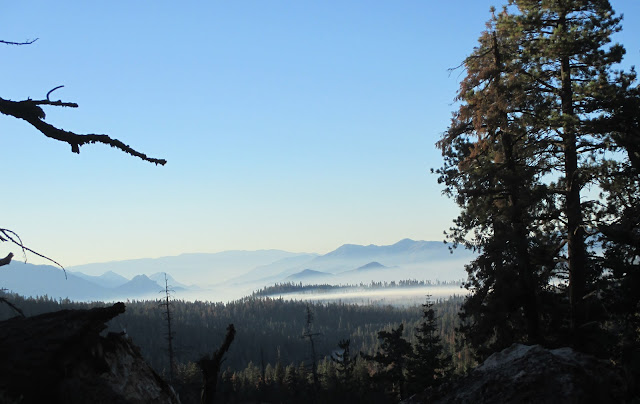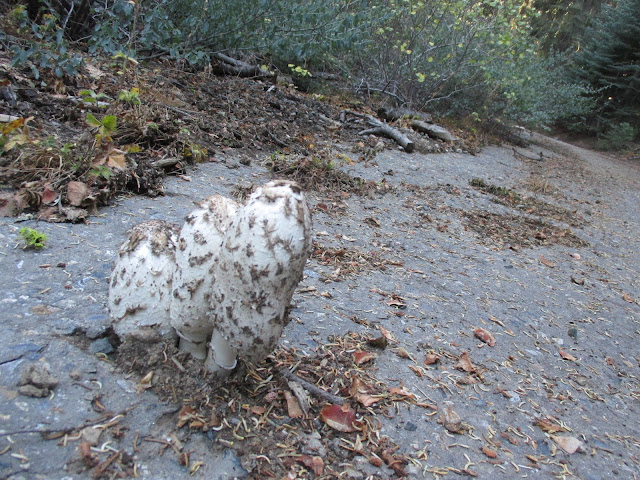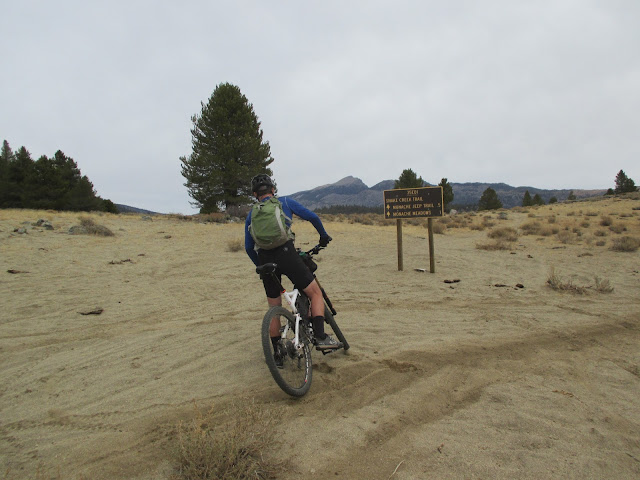 |
| Any day you can pedal through Giant Redwoods is a darn good day, says Erin Carroll |
November 2016 has been a very warm and dry month so far - perfect to go into the high mountains before there is too much snow. Erin Carroll is working on a long-distance bike packing route in the Sierra and wanted to scout a few more trails. Our target area was the Sequoia National Monument/Forest with a little bit in the Inyo National Forest on the last day, the Kern River Sierra. It is the area south of the Sequoia National Park and Mount Whitney.
Friday: Camp Nelson
We left Friday morning to get some riding in before dark - days are short in November. The riding started in the Giant Sequoia region at Camp Nelson. The ideal plan was a loop of Camp Nelson and Bear Creek Trail, but as we got to the top of Camp Nelson trail, Bear Creek was closed because of a Fire - the Slate Fire, which we would encounter a few more times. So we took the shorter Nelson Trail up and down. It is flowy at the bottom and more technical at the top, a very nice trail, but it takes time (lot of pushing going uphill).
 |
| Camp Nelson trail |
It was well after dark when we finished and quite chilly. Probably better that we could not do Bear Creek because most of the descent would have been in the dark. We had a primitive campsite higher up in the mountain in mind (Peppermint) and headed there. As we got closer, Erin thought he smelled a camp fire and commented that we were not the only people out that night. Then I smelled it too and it was getting stronger and stronger. Not only that, those campers must be using wet wood as the smoke reflected the headlights. And soon it was so smoky that the road was almost invisible. Ok, so not a campfire, but the smoldering remains of the Slate Fire. We backtracked and tried in the opposite direction and found actually an outstanding site off a dirt road. It was probably around 2200m and the night was cold, but didn't get down to freezing.
 |
| My little tent, a superlight Big Agnes that I really like |
Saturday: A false start and a long afternoon
 |
| Early morning view with smoke-filled valley below |
 |
| The Slate Fire smoldering in the distance |
We had a nice view from our campsite over a valley and Slate mountain. The fire burning in the distance is just where we would have had to climb up on the Bear Creek trail, so that trail was clearly not going to happen this month.
Instead, we tried the opposite direction and rode our bikes up a road to connect to Summit Trail, but it didn't take long before we hit another fire closure. Slate Fire in the South, now the Jacobson Fire was blocking our way north. As we found out later, both fires were caused by lightning two weeks earlier, but because it was already fairly wet and neither was aggressive, the forest service decided to let them burn out themselves. We tried some smaller trails on the map, but they were overgrown so that it was largely bushwhacking.
In between the bushwhacking, we came across several large meadows. Surprisingly, they were frozen, even though I was riding in short sleeves and shorts. In the summer, they are probably very swampy and packed with mosquitoes.
 |
| Add caption |
Then more circuitous riding as we got more off course. Even when we finally were on the Summit Trail, it was not in great shape. Most of the scrapes I collected this weekend were from the first 2 hours on Saturday.
As this area was not promising, we next tried to go south of the Slate Fire. The only option was the Western Divide Highway because all trails and dirt roads west of it were closed. Erin plans to use those dirt roads for his long-distance route, but we could not check them out because of the fire closures. The Trail of the 100 Giants is along the highway. Feels very touristy with all the paved walkways and big parking lots (and usually $5 parking fee). The trees are impressive, but then so are many of the trees elsewhere - maybe even more so without a concrete path leading to them.
 |
| At Trail of the 100 Giants |

 We went off pavement again at Parker Pass by 2 pm, promptly doing more bushwhacking (but not for long) before we found the dirt road. Long climb and then confusion again: We wanted to take Pup Meadows Trail, found the intersection where it should start, but not the trail. Probably half an hour riding up and down, and then way too far down the mountain and back up. We finally gave up and started to return - then we found it.
We went off pavement again at Parker Pass by 2 pm, promptly doing more bushwhacking (but not for long) before we found the dirt road. Long climb and then confusion again: We wanted to take Pup Meadows Trail, found the intersection where it should start, but not the trail. Probably half an hour riding up and down, and then way too far down the mountain and back up. We finally gave up and started to return - then we found it.
 |
| Mushrooms growing out of a crack in the asphalt |
Pup Meadows Trail was nice and may end up on the long-distance route. There would be a lovely camp spot at the highpoint.
It connects with some dirt roads that lead to Frog Meadow Campground where we wanted to go onto the next trail. We had problems finding Tobias trail at the campground because tree cutting messed up the area. Tobias trail parallels Tobias Creek through a steep and rocky canyon. This top part of Tobias is more for downhill riders and I don't think it is that much fun as part of a long ride. We reached the bottom just around sunset, but still had a long way back, which wasn't helped by missing a turn and ending up in Johnsondale, which added another hour of bonus miles - and mostly climbing.
Sunday: Kern Plateau
 |
| view into Domeland Wilderness, shortly after Sherman Pass |
Sunday started with a car ride: We went to the Eastern Sierra, the Kern Plateau. It is higher than the Western side, but also drier with less vegetation. It would be a long road ride on a bicycle and Sherman Pass might take the better part of a day. That day would have been great, no traffic at all. In the summer, that would be different, though.
We parked at the Blackrock ranger station and rode up Blackrock road (paved) to connect with the Granite-Broder Trail and later Blackrock Mountain Trail. This area is popular with offroad motorcyclists, so the trails are likely to be sandy during peak season and then probably not good for biking. After a bit of rain recently and no use, they were fairly well packed.
 |
| Eastern part of the Sierra is much drier and sandier |
 |
| Can't escape the sand in California, even at 2500m |
 |
| Olancha Peak, we were getting close, a bit over 12000 feet (but not quite 3700m) |
Blackrock Mountain Trail turned out to be a hard climb, but a nice trail. It is quite technical and long, so I don't expect it sees too much moto use and may always be in good condition. Our high point that day was around 2700m, maybe we hit 9000 feet. The Monache Mountain 4X4 road was fine for us, but likely to turn into a sand pit in the summer. It was hard climbing as is and with deeper sand would become a walk.
 |
| Blackrock Mountain Trail |
It took 4 hours to get to what I thought was not much more than the halfway point, so I was very skeptical about continuing, taking into account the experience of the previous day. But Erin was adamant that he wanted to do another trail and claimed that the conditions on this side of the mountains are much easier, trails are more used and maintained. And he was right, we were back at the car in just another 2 hours. The Beach Trail was also my favorite trail on that trip, so no complaints that Erin insisted on more trail riding.


































